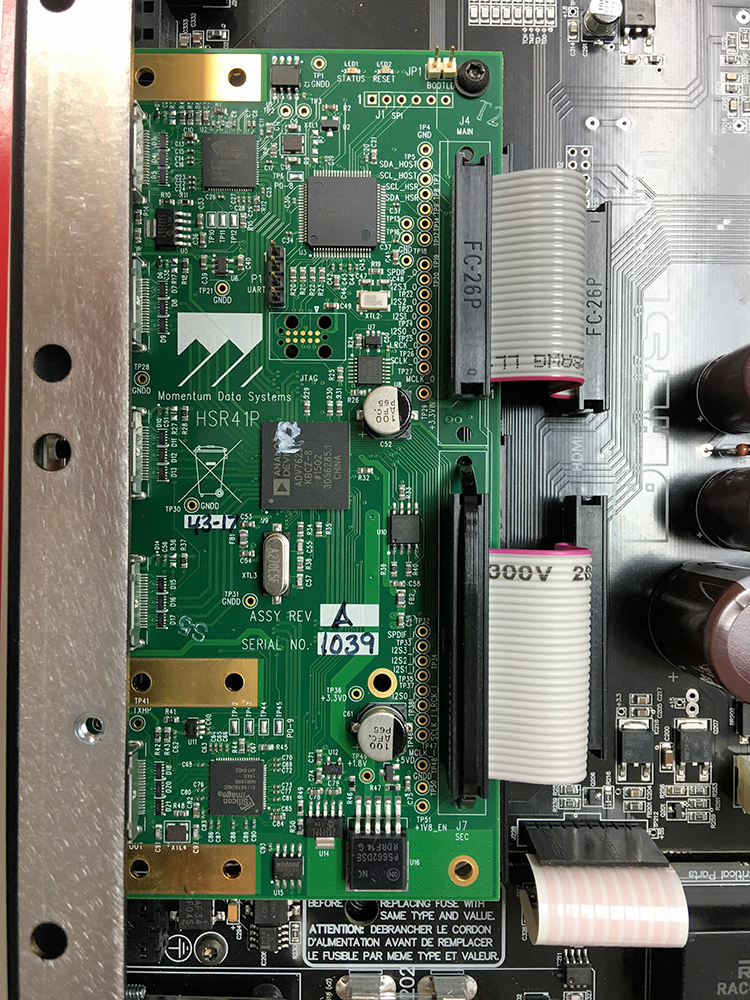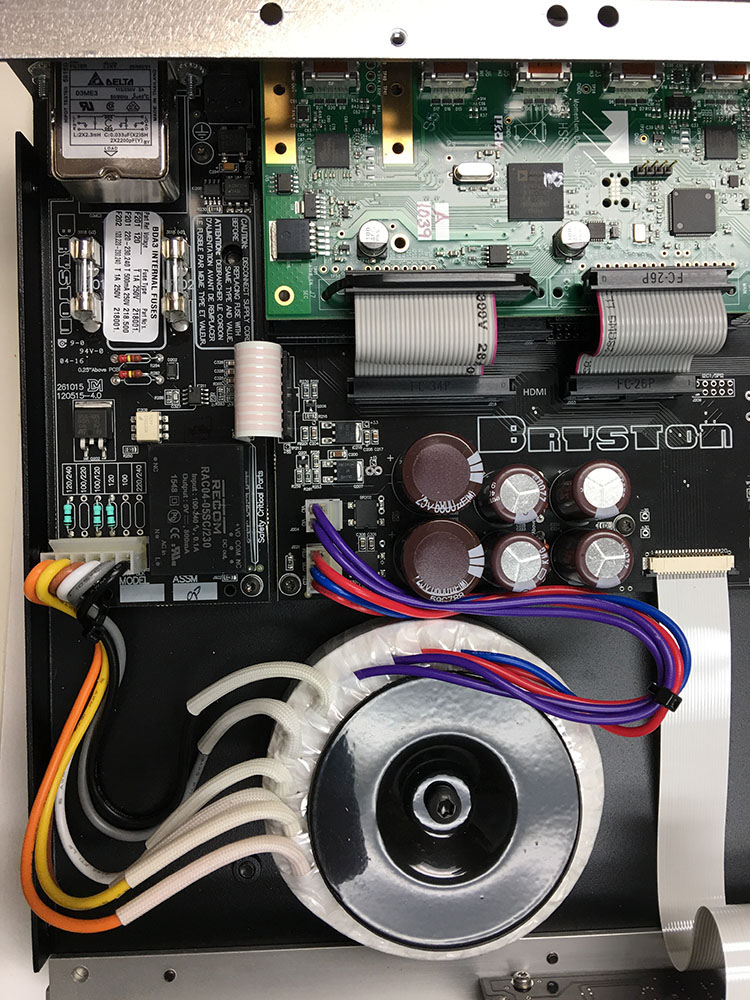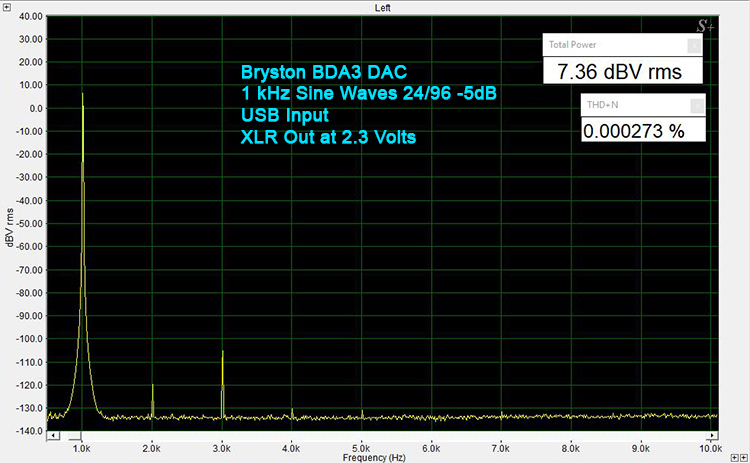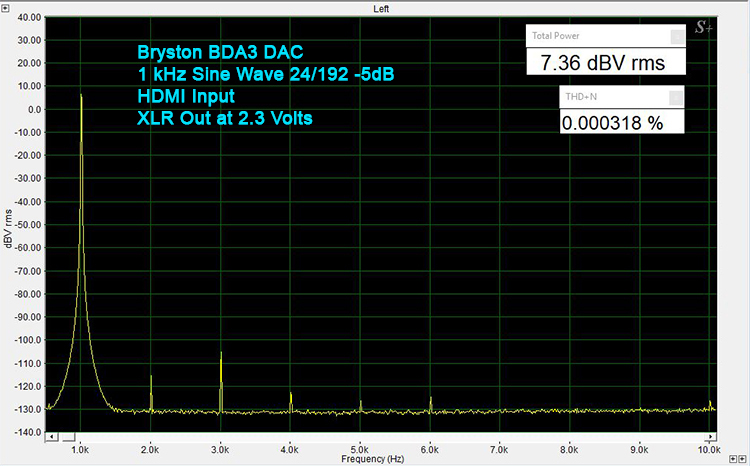They have broadened their speaker line with two new active models, and they have ventured deep into the analog realm by producing a statement turntable system. A new integrated amplifier and preamplifier have also appeared, branded under their “cubed” amplifier nomenclature. On the digital end, building upon the well-regarded BDA-2 DAC, Bryston has taken the wraps off their new BDA-3 DAC. It adds several new technical and connectivity features to elevate its capabilities and performance above its predecessor, not least of which are the four HDMI inputs supporting DSD and 4K video pass-through. The BDA-3’s expected sonic quality aims to match the norm for this brand (read, exceptional).

Bryston BDA-3 DAC
- Can play back up to 32-bit/384 kHz digital files in PCM and up to DSD-256 (via USB).
- A plethora of digital inputs including two asynchronous USB and four HDMI.
- DSD bitstream can be accepted over HDMI connection.
- HDMI connections allow up to 4K video passthrough.
- Dual AKM 4490EQ DACs used in Balanced mode for improved SNR.
- Impeccably well built.
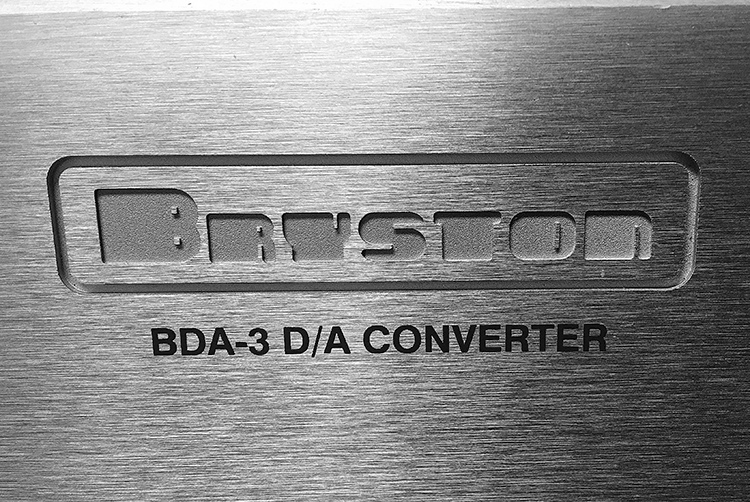
If you accused me of being a little biased towards Bryston‘s audio gear, I would have to admit to being guilty as charged. I’m not so biased as to not be able to call a spade-a-spade if we get a deficient piece of gear for testing. But I confess to harboring some nostalgia for the company as I grew up in Toronto and passed by their old manufacturing plant on a regular basis during my high school years. A few friends of mine who got into music production as we moved on to college, waxed poetic on the quality of Bryston‘s pro gear that was used in the studios that they trained at. That eventually got me to become an original owner of a BP-25 preamp that I still use to this day. That unit has been completely bulletproof in the 20-odd years that I have owned it. I also fall back on the experience that I’ve had playing with and testing other Bryston electronic equipment over the years. Speaking generally, I have found Bryston audio gear to be unfailingly neutral, imparting no discernible sonic character to the music I’ve listened to, beyond what is originally on the source. Some folks I know complain about Bryston amps sounding “sterile” or “lifeless,” but these friends tend be partial to tube amps or other gear that purposely doesn’t aim at neutrality as a job description in its resume.
Design:
2 Channel, Fully Balanced DAC
DAC Chipset:
Two 32bit AKM 4490EQ in dual-mono configuration
HDMI Section:
Momentum Data Systems HSR-41.2
Asynchronous Sample Rate Converter:
Burr Brown SRC43921
Frequency Response:
20Hz – 20kHz +/- 0.1 dB (manufacturer)
THD+N (1kHz):
0.002%
Digital Inputs:
Two Asynchronous USB 2.0, Four HDMI 1.4a (HDMI Input 4 is HDCP 2.2 compliant), One BNC SPDIF, One Coaxial SPDIF, One Optical TosLink, One AES/EBU (XLR)
Analog Outputs:
One pair of balanced XLR outputs (4.0VRMS), One pair of unbalanced RCA outputs (2.0VRMS)
Digital Sample Rates:
32, 44.1, 48, 88.2, 96, 176.2, 192 PCM (SPDIF, AES/EBU), DSD64 (HDMI, USB), 352, 384kHz PCM, DSD128 to DSD256 (USB only)
Control Interface:
Ethernet, RS232 and USB
Accessories:
Power cable, (optional BR-2 remote control is available separately.)
Colors:
Black or Silver
Dimensions:
17.0” W x 11.12” D x 3.63” H
Weight:
8.5 pounds
MSRP:
$3495.00
Company:
SECRETS Tags:
Bryston, DAC, HDMI, USB, DSD, Upsampling, DAC 2017
The BDA-3 DAC that we have here today tangibly follows all the expected Bryston credos in terms of build quality and design. The addition of four HDMI inputs that can accept DSD bitstreams, and two asynchronous USB inputs that can do the same are welcome and unique features, folded into an already well regarded base foundation. The BDA-3 builds off the already widely lauded BDA-2 DAC which received a Secrets Best of 2013 award for Best High-End DAC that we reviewed that year. Let’s see if the BDA-3 carries on the tradition of exemplary performance that we’ve become accustomed to in Bryston gear.
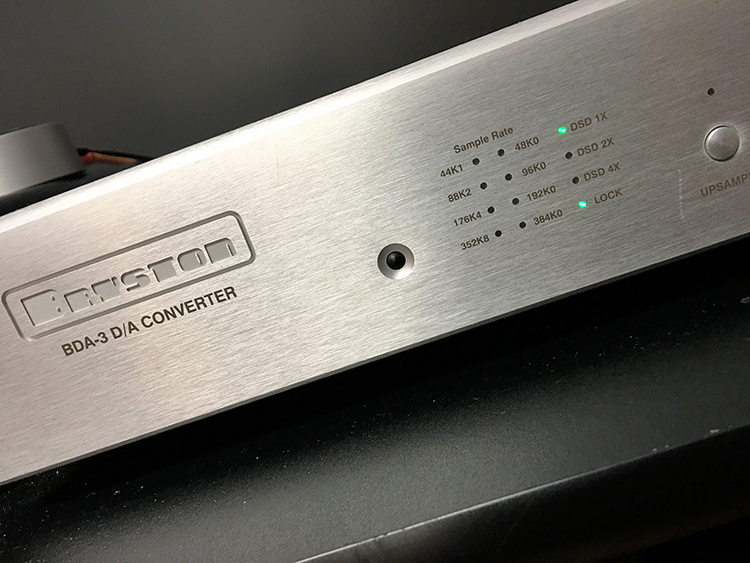
From a technical standpoint, the Bryston BDA-3 uses two 32-bit AKM 4490EQ Veritas stereo DAC chips. The 4490EQ were AKM’s flagship DACs upon their release in 2014 and are in widespread use today in a number of hi-end audio products and applications. The chips themselves can support digital input signals up to 768 kHz PCM and 11.2 MHz DSD, although as applied in the BDA-3 design, Bryston caps the PCM digital input to half that figure, which is the SPDIF limit. While there may be some other stand-alone DAC boxes out there that will pass 768 kHz over USB, I don’t know of any consumer music material that is available at such a high sampling rate in the first place. AKM’s marketing materials state that the chips are rated as having a S/N figure of 123dB and THD+N specs of -112dB. However, AKM’s engineering notes put the worst-case scenario figures at 115 dB stereo SNR and 118 dB mono SNR with a THD+N at -100 dB. What is interesting about the BDA-3’s design is that Bryston uses two of these DAC chips in a dual-mono configuration, improving the aforementioned S/N figures by 3 dB, and their output is sent through Bryston’s custom discreet and fully balanced Class-A output stage. I should mention that before the incoming digital signal even gets to the DAC chips, the BDA-3 removes the embedded timing information from the incoming signal and re-clocks the data against its own proprietary master clock, thus minimizing potential jitter issues.
Secrets Sponsor
A look inside the BDA-3 reveals a clean and well thought out layout with high quality parts and construction used throughout. The large toroidal transformer, connected to robust power reserves and filtration on the main control PCB, powers a series of individual boards. The HDMI board is separate from the dual-input USB board (underneath the HDMI board) which is separated from the DAC / output-stage board as well.
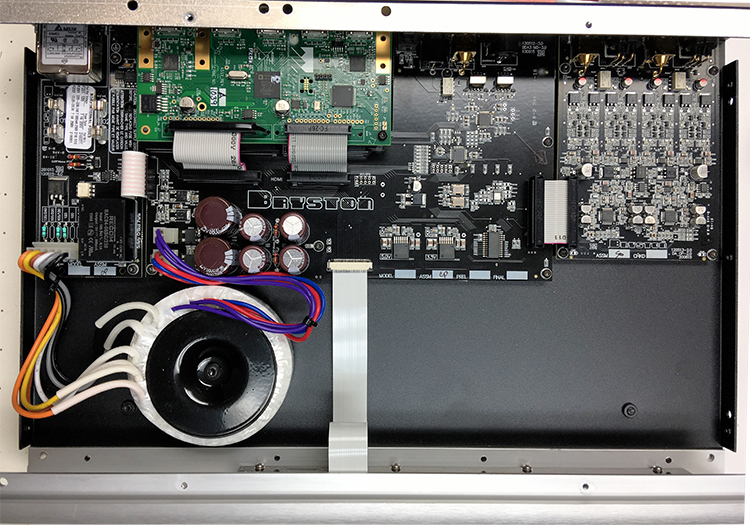
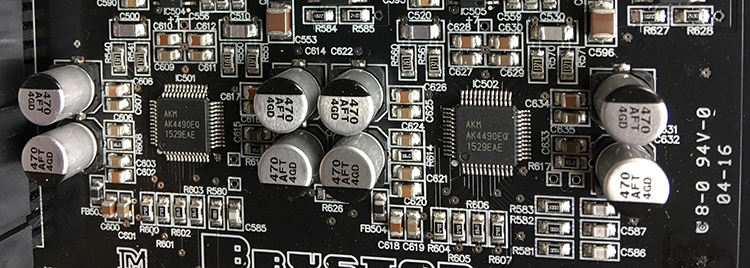
Dwelling on the individual inputs for a moment, while the two asynchronous USB inputs provide the most flexibility in terms of input signal support (32-bit / 384 kHz PCM and direct DSD along with DSD over PCM/DoP), the four HDMI inputs with 4K video pass-through are probably the key differentiator on this DAC. The whole raison d’être of the HDMI standard was to maintain copy protection for high bandwidth digital sources, such as Blu-ray and SACD players. The BDA-3 is one of only a handful of standalone DACs that I’ve seen which offer HDMI connectivity.
The remaining digital inputs consist of one coaxial and one BNC SPDIF connectors, one optical TOSLINK connector and an AES/EBU (XLR) connector. All told the Bryston BDA-3 has ten available digital inputs making this thing a veritable switchboard of digital connectivity.
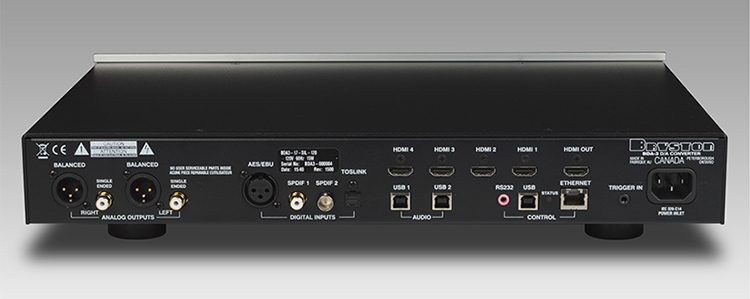

The BDA-3’s front panel is a model of simple cleanliness. Starting from the left there are three columns of micro-LED lights that indicate the incoming signal rate, format and signal lock. To the right of this we have the first of a series of twelve identically sized buttons. The first one, marked “Upsample”, allows any PCM signal, except those coming over HDMI or USB, to be upsampled in 44.1 or 48 kHz multiples. The next ten buttons represent each of the 10 available digital inputs. The final button toggles the power on and off. There is an optionally available BR2 remote control that Bryston offers which will control many of the switching functions of this DAC. I did not have that as part of this review however.
For this review, the connected components consisted of: An OPPO BDP-105D Universal Disc Player, a Bryston BP-25 preamplifier, HiFiMAN HE1000 v2 headphone, a Class D Audio SDS-470C Power amplifier (300 watts @ 8 ohm, 600 watts @ 4 ohm), Paradigm Persona 7F loudspeakers (review forthcoming) and a Panamax M5500 power conditioner. Speaker wire and interconnect cable by Blue Jeans Cable. All interconnect cables were balanced XLR.
For computer based audio playback, I used my Microsoft Surface 3 Pro tablet running J. River Media Center 21 software and Bryston’s USB ASIO drivers for Windows.
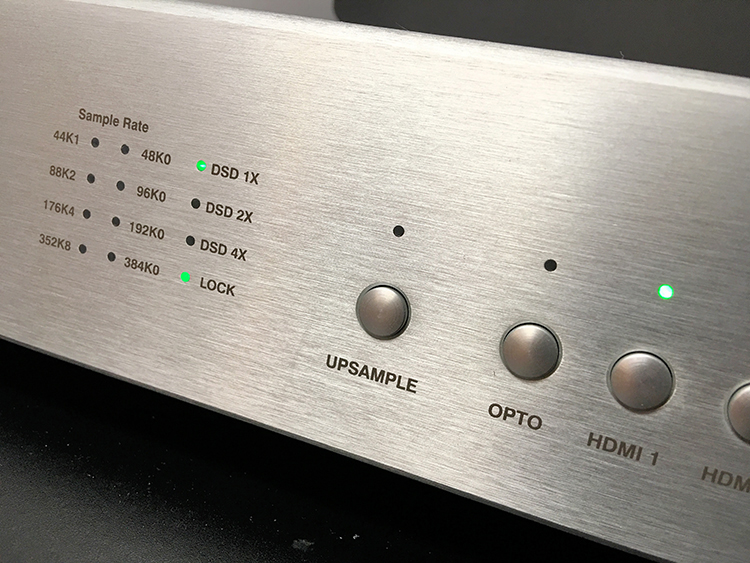
Well-designed DACs can be a particularly tricky component to make a subjective judgement on. As reviewers, we can take measurements and get some empirical evidence to draw conclusions from but when using our ears, it can make the job a little more daunting. You have your doubts? Well, let me explain my reasoning to you. In my mind, a textbook DAC should decode and process a digital signal to analog as completely as possible, with no errors and imparting no additional sonic characteristics of its own. Makes sense, right? And with chip designs today being as good as they are, when put in the hands of skilled manufacturers, you get several state-of-the-art products that can require intense scrutiny to tell apart audibly. It mostly comes down to implementation of the digital filtering and the design of the analog stages that make the biggest sonic differences in quality stand-alone DACs.
Secrets Sponsor
I am always amused at people who claim to be able to casually and easily tell the sonic differences between well designed DACs, making it appear so obvious that anyone should be able to tell. While I may not have been blessed with “Golden Ears”, I do know that mine work rather well, as I have them regularly tested. I also have a pretty healthy BS meter, and when I hear or read florid prose about the aural delights of a given DAC, that meter tends to go off rather smartly. I’ve had a chance to listen to a wide variety of DACs over the years, and of the really good ones that have an obvious sonic signature, it’s mainly because they’ve been intentionally designed that way. Whether it’s through things like the use of tubes in the output stages or other combinations of design choices, an obvious sonic signature in a state-of-the-art DAC means a conscious decision was made to go for impression over ultimate accuracy. Now, is that necessarily a bad thing? Not exactly.
Music is a subjective thing and if you find an audio component that increases your enjoyment of your favorite tunes or satisfies a certain hearing bias, for whatever reason, then more power to you. Speaking personally, I covet accuracy in my DACs of choice. When it comes to colorations and sonic signatures, I prefer that to happen at the speaker level, or even the amp level if I’m craving the sound of tubes. But when it comes to DACs, I tend to agree with the words of the immortal Dr. Johnny Fever: “Give it to me straight doctor, I can take it!”
So, as I gingerly step down off my soapbox, where does that leave us with the unit in question? The Bryston BDA-3 is as clean and un-colored sounding a DAC as I have ever heard. As far as I can tell, it imparts no sonic signature of its own to any material that I ran through it, whether I was using SPDIF, USB or HDMI inputs. As you’ll see in the Bench Test section, some inputs may have measured a little better than others, but the differences were near enough as to be inaudible. To my ears it sounded utterly flawless but these days, many top tier DACs do. The truth is, I initially had a rough time telling the difference in sound from the Bryston to the balanced analog output of my OPPO BDP-105D. The OPPO uses a single ESS 9018 Sabre DAC (8 channels total, 4 summed to the left and 4 summed to the right for a theoretical 6 dB improvement in SNR) for stereo on its analog XLR output, and listening over speakers while sitting two meters away made for an honestly hard comparison. Or, at least, it was tricky to make a reliable comparison.
It was when I strapped on my headphones and switched between balanced inputs on my preamp while the two were playing simultaneously, at matched levels, that I was able to discern some meaningful sonic differences. The Bryston sounded undoubtedly cleaner than the OPPO BDP-105, particularly in the bass regions where I noted some slight fuzziness in the OPPO when it played back electric and double bass lines. There were also a couple of cases where I found horns and brass sounded just a little more etched with the OPPO versus just sounding more natural with the BDA-3. When I began peppering the DACs with complex orchestral pieces, the Bryston again began to distinguish itself by giving me a little more perceived detail in the individual instruments. This was especially true in some of the low level percussive stuff that may not always sound the clearest. The OPPO was good but the Bryston was, subjectively, spotless. In reality, these weren’t night-and-day differences by any stretch, but they were noticeable ones at close inspection and it’s the kind of thing that matters when you are looking for every last drop of performance.
Operationally, I encountered no issues when I played back SACDs, via HDMI, through the BDA-3. I just set up my OPPO player to bitstream DSD through its appropriate HDMI output, I hit the play button, the little DSD 1X and Lock lights lit up on the Bryston, and musical goodness emanated forth from my speakers. Easy-peesy. To get the DSD 2X and 4X lights to come on I needed to use one of the USB inputs and play back the appropriate material from my Surface Tablet using J. River Media Center software and the appropriate ASIO drivers downloaded from Bryston’s website. Whether I listened to native DSD files from my tablet or I set the software to upconvert regular PCM to DSD 2X or 4X, the Bryston gave me nary a hiccup in playback. One word of note though, you may have to increase the buffer size that your music software uses when dealing with such large amounts of data. Skipping can occur if you leave it at the default settings. This, though, has everything to do with the processing power of your computer and not the BDA-3. Give this DAC a clean bitstream and it will decode it without drama.
I experimented with the upsampling feature when playing CD’s via the Coaxial and Optical inputs. With this feature active, an incoming 44.1kHz signal will be upconverted to 176.4kHz and the indicator light glows amber (the same applies to an incoming 88.2kHz signal). If you send the BDA-3 a 48 or 96kHz signal, upsampling will kick it up to 192kHz and the indicator light will turn green. I did think I heard a minor improvement on some tracks that I tried the upsampling feature on while others, not so much. In my experience, I’ve found that your mileage will vary with these types of sampling features and perceived results are very dependent on the material that you’re listening to. The BDA-3 upsampler continued to bear that view out so I didn’t dwell on it too much and I chalk it up to being a neat feature to have and experiment with.
Some of the musical selections that I found particularly enjoyable in my time with the BDA-3 were:

Fiona Joy, Signature Solo, Blue Coast Records SACD. A very nice, if somewhat moody sounding, recording of a solo piano being expertly played. If the old saw is true, that the piano is the hardest instrument to reproduce correctly, then the BDA-3 should truly win a prize for how it handles this material.
All the spatial cues sound completely natural. From the hammers hitting each string, through the purity of the created tone, into the resultant ring and then decay of the sound, each note on this disc seems as clear as glass and handled with the utmost care. One thing I always look for on piano recordings is how the lower register notes sound, and if the inherent “weight” of those tones comes across successfully. On the opening track “Ceremony,” the Bryston DAC translates those lower notes most effectively, to a point where you can almost feel their dimension. It’s the contrast of the feel of those lower notes to the ring and sparkle of the middle higher notes that make the piano such a beautiful instrument to listen to live. For its part, the BDA-3 performed its role admirably to help extend that illusion into my listening space. In the song “Once Upon Impossible,” Miss Joy’s piano playing is supported and punctuated by short bursts of some of the softest acoustic guitar that I have possibly ever heard recorded. While low in level and intermittent in occurrence, the BDA-3 easily relayed all the information that was there, right down to the slight rasp of the of the guitar strings that made it to the recording. Detail retrieval with this DAC is truly outstanding.

Junior Brown, Volume Ten, JRB Music CD. The most recent CD from the eccentric country guitar virtuoso and his band. What stood out most to me about this recording was how well the Bryston DAC relayed the whole of a tightly put together six-piece, band and still caught all the nuance and details of each instrument as it was laid down in the mix.
And if you’ve never heard Junior Brown’s vocals before, you are missing one of the most wry and distinctive baritone drawls that is out there in music today. On the track “Hang Up and Drive” the BDA-3 dishes out all manner of musical specificity. From the distinct sound of the brushes sweeping on the drum skins, to the scrapes on the acoustic rhythm guitar strings, to the rightness of that Telecaster “twang” on Brown’s lead guitar. It’s all there and clear as day to hear. Switching to the almost comically smooth and jazzy sound of “Apathy Waltz,” Junior Brown’s voice shines with such a richness of depth and a clarity of tone that you almost miss the absurd irony of the lyrics that he’s singing. The Bryston mines every ounce of character in that deep voice which thankfully gave the Paradigm Persona speakers that I had hooked up, more than enough information to throw out a huge and satisfying image. Scrutinize that song a little more and you discover those great sounding drum brushes again, that substantial and detailed rhythm guitar and a meaty double bass line rendered in perfect clarity. As a closer, Brown’s version of the hillbilly jazz classic “Almost To Tulsa” is a case study in his capabilities as a guitar slinger. Subtly yet seamlessly weaving nods to surf music, jazz, country and Hendrix into this outstanding instrumental, the Bryston BDA-3 digs out all the information there is, from broad strokes to nuance, and arranges it all perfectly for consumption, down to even the slightest hint of amplifier buzz. It’s all there, and awesome stuff it is!

Scheherazade, Kirov Orchestra with Valery Gergiev Conducting, Phillips SACD. While perhaps not my favorite performance of this symphonic suite (that is still a Vanguard recording from 1957 on vinyl, never released on CD) there is no denying that this is a well put together, command performance of the material.
The solo violin alone in “The Sea and Sinbad’s Ship” sounds so natural and melodious in the hands of the Bryston. And as the flute and other individual stringed instruments weave in and out with that violin, you acquire more of a sense of the performance space, with the ambience becoming bigger and clearer. And then, the entire mass of the orchestra comes in, powerfully, and your eyes widen as you become aware of the full measure of the space and the performers and the fact that you can hear each of the sections so distinctly. This could easily sound like mush at this point but the BDA-3 prevents that possibility from even considering rearing its ugly head. The variety of tones of each of the woodwind instruments was one of the things that really stood out to me and was something that I had not noticed before. The brass instruments were sharp and bright sounding as they should have been without seeming etched or harsh at all. Whenever there were sharp plucks at the harps, the Bryston actually allowed me to hear the string reverberation more clearly than I was used to. I could go on, but you get the idea. If you give the BDA-3 a big, dynamic recording with lots of moving parts, it will allow you to focus your attention on any and every one of those moving parts if you wish, or simply enjoy the masterful whole.
Benchmark audio tests were conducted on the HDMI, SPDIF and USB digital inputs of the Bryston BDA-3 DAC. Various custom digital test tones were sent through the Bryston using an OPPO BDP-105D or a Microsoft Surface PRO 3 as the source and measured with SpectraPLUS audio measurement software via a LYNX TWO B professional sound card. A 1kHz test tone measured with a voltmeter at both sets of analog outputs showed the unbalanced outputs produced exactly 2 Volts RMS while the balanced XLR outputs measured at exactly 4 Volts RMS. Unless otherwise stated, all measurements were taken from the Bryston’s balanced XLR outputs.
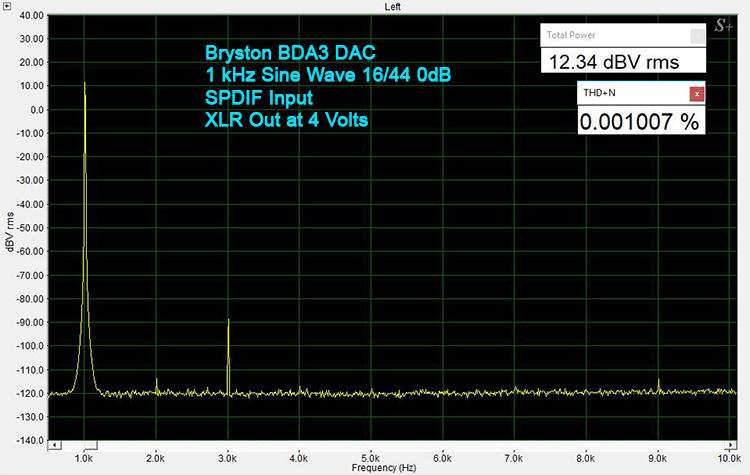
Beginning with the coaxial SPDIF digital input, a 1 kHz 16/44.1, full-scale 0 dBFS sine wave gives us a THD+N figure of 0.001007%. We see a smidge of a second harmonic, at 2 kHz, being almost 120 dB below 4 VRMS, which is good, and a third order, at 3 kHz, at 102 dB below 4 VRMS which is less than ideal.
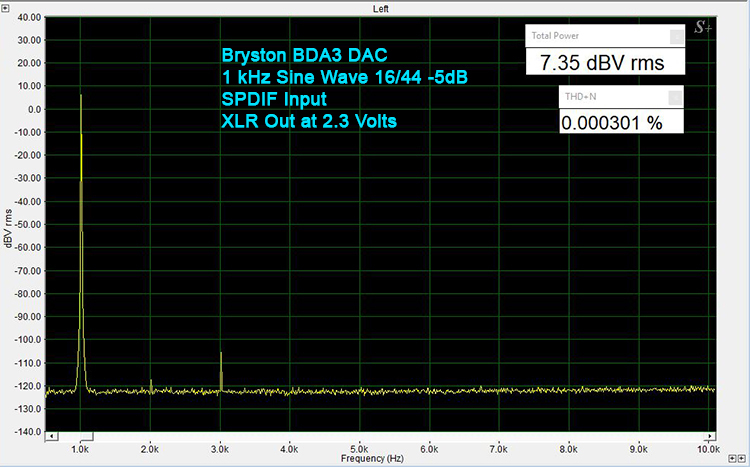
Using the same tone at a -5 dBFS level, we get a THD+N figure of 0.000301%. The same two harmonics appear, but at even lower levels below 2.3 VRMS. The second harmonic is at -120 dB and the third is at -112 dB.
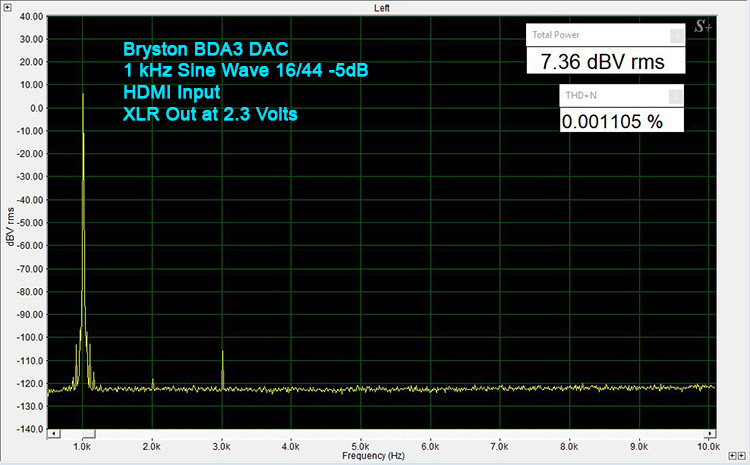
Repeating the same 1 kHz 16/44.1 tone at -5 dBFS level through the HDMI input gives us similar results in terms of harmonics to the previous graph but a few sidebands begin to creep in close to the fundamental tone. This is a little curious as I would expect a properly implemented ASRC chip (Burr Brown SRC43921 here) to mitigate this kind of situation that results from correlated jitter, which is more of an issue with HDMI. The THD+N figure is slightly worse at 0.001105%. Not that you would actually hear that difference.
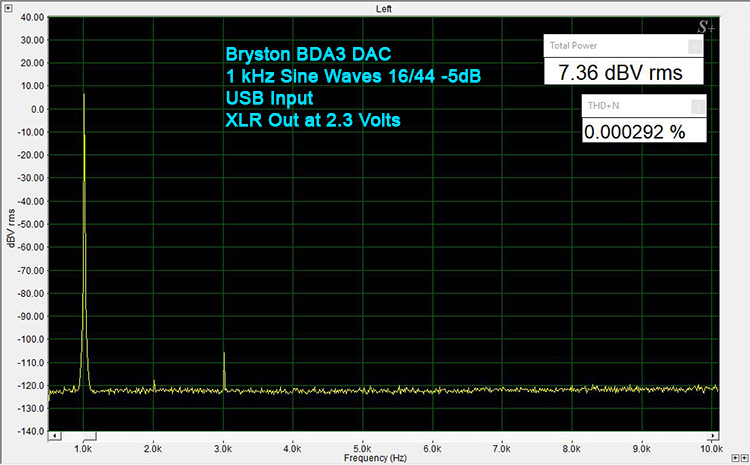
The same test again, through the USB, input gives us almost identical results as the SPDIF test. The THD+N figure here is 0.000292%.
Repeating the same 1 kHz, -5dBFS test but at both 24/96 and 24/192 bit-depths show a similar pattern of results when compared to the 16/44.1 tests. The biggest difference being the lower FFT processed gained noise floor afforded by the 24-bit test signals. This is related to, but is not, the SNR. My colleague David Rich will publish a Secrets tech article, in the near future, on processing gain in FFT spectra. The HDMI input shows sidebands right around the fundamental at 24/96 and two or three more tiny spurs showing up in the 24/192 spectra. Again, this is a little surprising due to the use of an ASRC chip
Otherwise, all the THD+N numbers on these 1 kHz tests are outstandingly low, surpassing the results of the previous generation Bryston BDA-2 that John Johnson tested in 2013.
The next two measurements are using a 0 dBFS, 1kHz test tone at 24/192 being measured through HDMI and USB respectively.
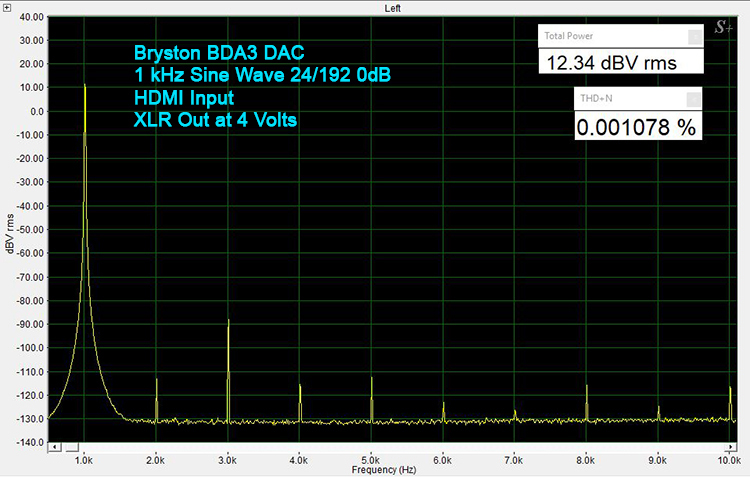
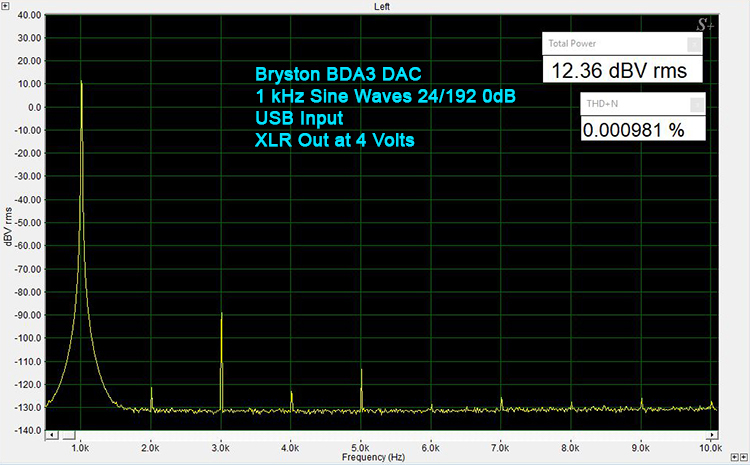
Both of these measurements have almost identical THD+N performance at about 0.001%. Of the two, the USB measurement seems to have a lower number of harmonics and distortion spurs above 5 kHz.
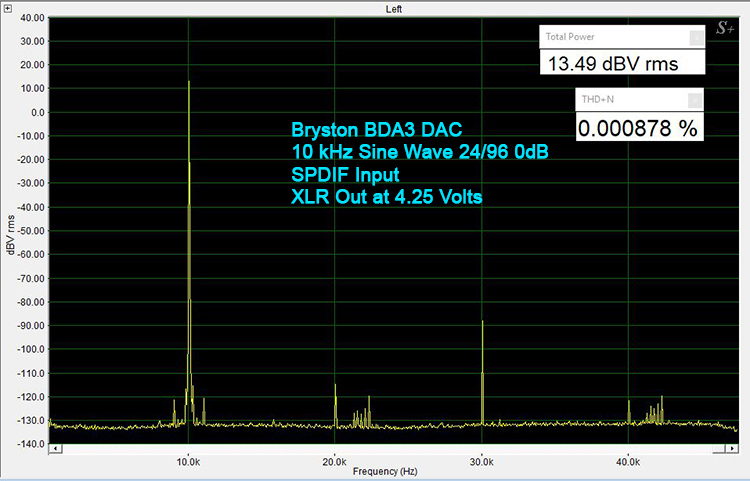

The above measurements are of a 10 kHz sine wave at 24/96 with a level of 0FS dB taken at the SPDIF and HDMI inputs. The SPDIF input has the lower THD+N figure of the two, 0.000878% versus 0.009608% for the HDMI. Both have similar harmonic distortion profiles, with the second order spur at 20 kHz measuring 125dB below 4 volts and the third order spur at 30 kHz being 100 dB below 4 volts. The SPDIF image also looks cleaner around the fundamental with two clear, sidebands while the two HDMI sidebands look more distorted around the same area.

The 19 kHz, 20 kHz combined test frequencies at 16/44.1 and at -11dBFS using the HDMI input show small side bands near the fundamental and no visible B-A peak around 1 KHz.
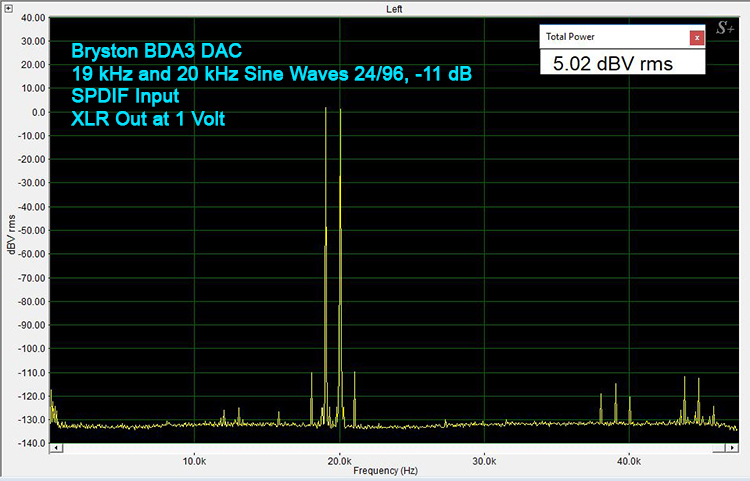
The 19 kHz, 20 kHz combined test frequencies at 24/96 and at -11 dBFS using the SPDIF input show only two side bands both registering at about 110 dB below the fundamental. There is a visible B-A peak at 1 kHz about 118 dB below 1.1 VRMS. We see a couple of very minor distortion spurs in the spectrum. The second harmonics at 38 kHz and 40 kHz are about 120 dB below 1.1 VRMS. There are two slightly larger distortion spurs at 43 and 44kHz at about 112 dB below 1.1 VRMS. The source of this is not easy to understand.
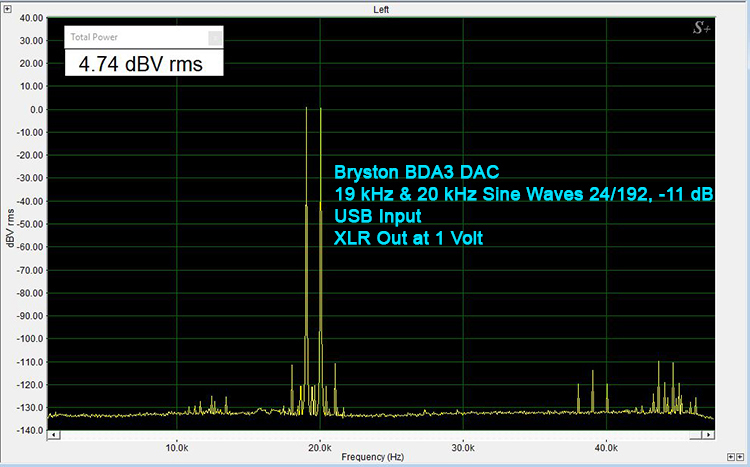
The 19 kHz, 20 kHz combined test frequencies at 24/192 using the USB input show only two side bands both registering at about 110 dB below the fundamental. Note the tones inside the 19 kHz and 21 kHz. The source of these is not clear. They are not seen with 96k sampling. There is no visible B-A peak at 1 kHz. We see a couple of very minor distortion spurs in the spectrum. The second harmonics at 38 kHz and 40 kHz are about 120 dB below 1 VRMS. There are two slightly larger distortion spurs at 43 and 44kHz at about 112 dB below 1 VRMS. Again, the source of these is not easy to understand.
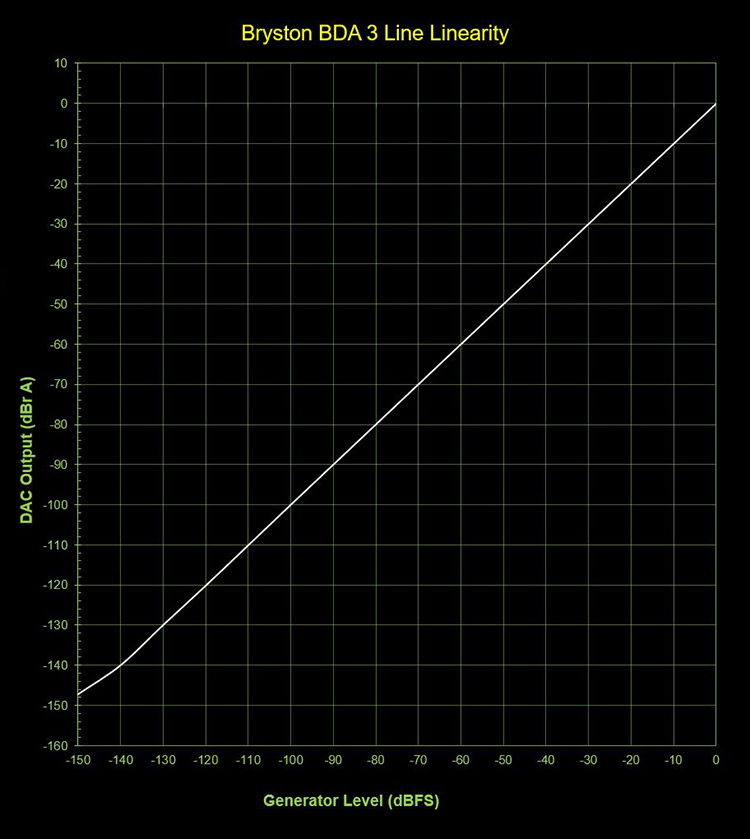
As I don’t have an instrument that automatically measures DAC linearity, I plotted this chart that is culled from a series of progressively lowered 24bit 1kHz tones. An ideal linearity measurement would show a perfectly diagonal line from 0 dB down to the DAC noise floor, indicating that measured DAC output level is identical to signal input level. As you can see the Bryston BDA-3, while of course is not perfect, measures exceptionally well.

This Relative Linearity chart shows in a more exaggerated, and easy to see manner, that the BDA-3 exhibits the most miniscule levels of linearity error starting at -100 dBFS, becoming more noticeable at -130 dBFS and then turning more significant at -145 dBFS, which is at about the DAC noise floor. We had determined that a constant processing gain adjustment of 23.32 dB needed to be applied to the measured tones as a result of a scaling issue with my sound card.
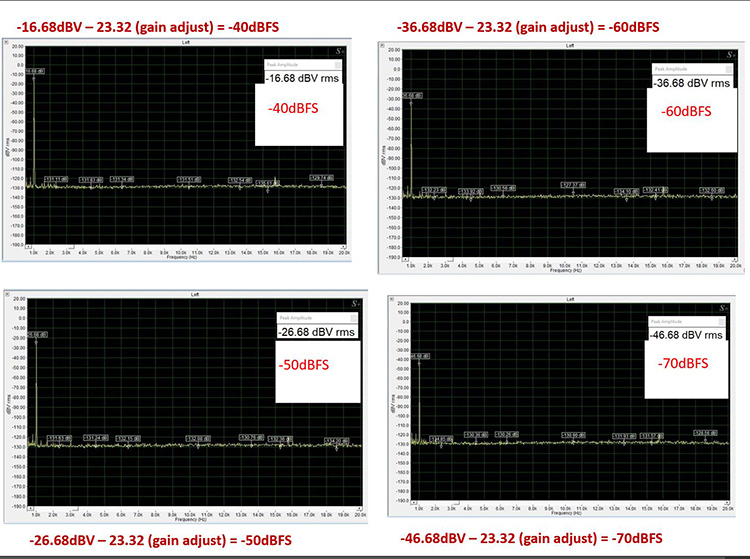

These are examples of some of the measurements that I took to put the Line Linearity chart together. A series of fifteen measurements of a 24-bit, 1 kHz tone beginning at -20 dBFS and getting progressively lower in level to -150 dBFS were taken through the coaxial digital input of the BDA-3. After compensation, the lowest tone is at -154.3 dBFS which is off 4.3 dB from the digital input of -150 dBFS. Just for the sake of curiosity, the spurs to the left of the 1 kHz tone are residual power line hum at about -147 dB. This defines “dead quiet.”
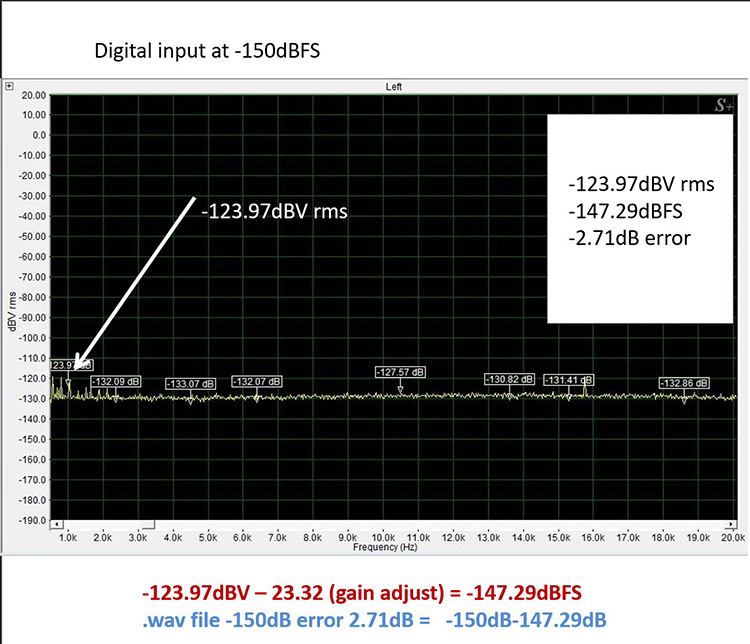
Note that the specified SNR of my Lynx TWO B sound card, with no attenuation, for a signal with a 4 VRMS level is 122 dB. The FFT processing gain is letting us see below the noise to view the 150dBFS signal.
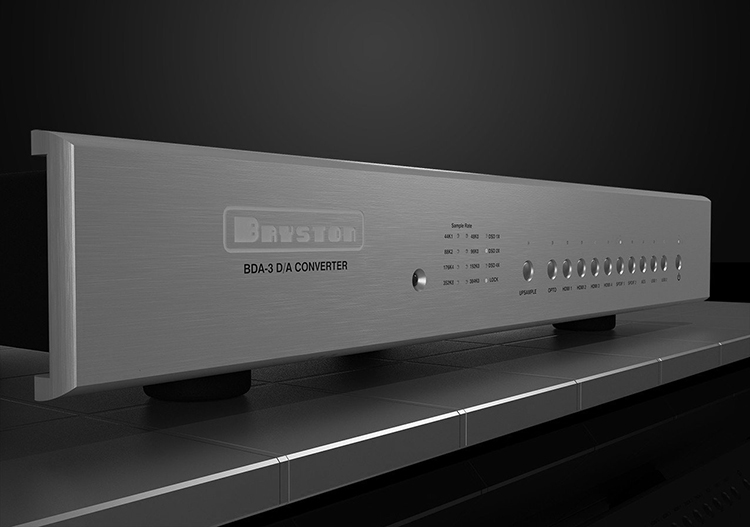
THE BRYSTON BDA-3 DAC is almost the perfect nexus of sonic and tactile excellence. You could spend more, but why?
- Impressive array of inputs. I mean there are ten for the love of Pete!
- Superb build quality.
- Outstanding sound quality from all inputs and sources.
- HDMI connectivity with DSD bitstreaming is a practical and desirable feature for a DAC these days.
- An included remote, specific for this DAC.
- Better measured jitter rejection on the HDMI inputs.
- It should be able to serve me warm cookies!
The Bryston BDA-3 is an exceptionally transparent piece of audio gear. It builds on the already impressive performance of the previous generation BDA-2 and bests its measured performance in most respects. It also improves on its predecessor’s feature set by having four HDMI inputs that allow DSD bitstreaming and two asynchronous USB inputs. This puts the BDA-3 in rarified company already. That, however, would be meaningless if it didn’t sound good and wasn’t built to last. Beyond the mention of increased measured jitter on the HDMI inputs, from first note to last, it’s sound is subjectively as clean and clear as could be. The build quality and design are typical Bryston, and that means essentially bulletproof. While $3495.00 is not just pocket change these days, it’s a worthy price for a piece of gear like this. Can you find another DAC that sounds almost as good for less money? Sure. But as the saying goes, “Close only counts in horseshoes and hand grenades.” If you want to hear it all, and I mean every last bit of it, plunk down your pocketbook on a Bryston BDA-3. You will not regret it
The author would also like to thank Dr. David Rich for his contributions to this review.




